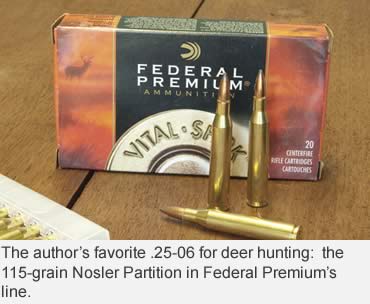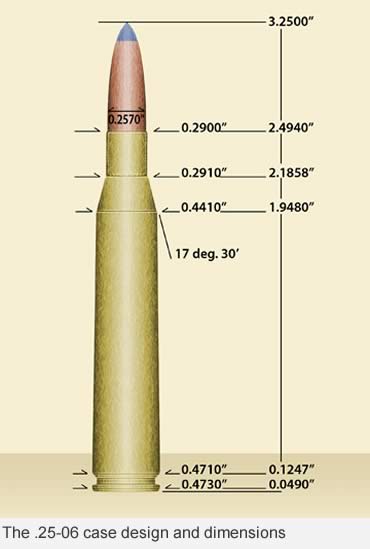In the hands of an experienced hunter, the quarter bore shines.
One thing I’ve learned over the years as a hunter and writer is that hunters seldom agree about which rifles and cartridges are best, particularly those used for deer hunting.
The truth is, no one caliber can do it all across the whitetail’s vast range: open prairies, hardwood swamps, mountains, dense thickets, etc. Rather than relying on a single caliber, I have several favorites for different terrains. What follows is a case for the .25-06, which is effective across much of the whitetail’s U.S. range.
Around 1975, I read something Bob Hagel had written about the .25-06. The late gun writer noted that the 115-grain Nosler Partition bullet was unusually devastating when fired from a .25-06. In the hands of an experienced hunter, he wrote, the combo is potent on elk as well.
I was captivated by Hagel’s comments and decided to give the .25-06 a try. I had never hunted elk with this combination, but I can tell you that countless whitetails and mule deer wish I’d never read Mr. Hagel’s words.
My first .25-06 was a rebarreled pre-64 Winchester Model 70. It had a 24-inch Douglas Premium barrel with a 1-in-10-inch twist, ideal for the 115-grain Nosler Partition bullet. With 52.5 grains of IMR 4831 powder (the maximum load for this rifle), muzzle velocity was 3,160 fps and accuracy was exceptional, with three-shot groups of 1/2 inch or less at 100 yards.
Famed gunsmith A.O. Neidner introduced the .25-06 as a wildcat cartridge in 1920. Formed by necking the .30-06 case down to .25 caliber, it really didn’t come into its own until after World War II when slower-burning powders became available to handloaders. IMR 4350 boosted velocities without excessive pressures, and then Hodgdon 4831 came along and eclipsed velocities achieved with IMR 4350. Suddenly, the .25-06 was capable of magnum velocity, substantially exceeding its former rival, the .257 Roberts. In 1970, Remington adopted the wildcat as a factory cartridge.
The .25-06 had remarkable medium-size big game shooting potential with any number of bullets from 100 to 120 grains. But with Nosler’s 115-grain Partition, penetration performance seemed to defy logic.
 My first hunt with that rifle and load was in northern California for Columbia blacktails. On the last evening of the hunt, I spotted a handsome buck across a wide draw. The buck was standing above me, facing downhill on the mountain. When I touched off the shot, the buck virtually dissolved from my view.
My first hunt with that rifle and load was in northern California for Columbia blacktails. On the last evening of the hunt, I spotted a handsome buck across a wide draw. The buck was standing above me, facing downhill on the mountain. When I touched off the shot, the buck virtually dissolved from my view.
It was almost dark when I got to him. The 115-grain Nosler bullet had traveled the full length of the deer — through bone — and still exited! I was astounded. So was the buck, which dropped in his tracks. Over the next 10 years, I experienced similar results on deer of all sizes, including a number of large Alberta whitetails.
In those days, I was still in the guiding and outfitting business in Alberta. On one occasion, I was tracking a wounded buck in the snow. One of my hunters had made a bad shot, and the deer was traveling on three legs. I walked up on the buck and jumped it out of its bed at about 30 yards. The big-bodied deer lunged straight away from me as it boiled out of its bed. I swung my .25-06 to my shoulder and shot it going straight away on its second bound. It folded up like a scalded spider.
When I skinned the buck, which weighed 255 pounds field-dressed, I made a startling discovery. The bullet came to rest just under the skin. It was one of two .25-caliber, 115-grain Nosler Partition bullets I have recovered from deer-size game. I estimate that I have shot more than 100 deer with this bullet/caliber combination, and, in all but two cases, the bullet drove through and exited.
Some will argue that the ultimate bullet performance occurs when the bullet stacks up under the hide on the offside of the animal. My experience tells me something different. I tried other bullets in my .25-06, and some expanded to the classic mushroom and came to rest under the hide on the offside of the animal. While these shots were ultimately fatal, the game ran 50 to 100 yards before dropping. In most cases, these were broadside, center-lung shots. Similar shots with the 115-grain Nosler Partition would drop the animals in their tracks, and, in every case, the bullet would exit the offside.
 On both whitetails and mule deer, I distinctly remember making center-lung shots and watching the deer jump straight up in the air upon bullet impact, only to come down in a heap without taking a single step. Unusual devastation, to say the least. I can’t explain how or why it happens, but I can say from much experience it’s a common response. I have taken game from point-blank range all the way out to 400 yards with this combo. The results are always devastating.
On both whitetails and mule deer, I distinctly remember making center-lung shots and watching the deer jump straight up in the air upon bullet impact, only to come down in a heap without taking a single step. Unusual devastation, to say the least. I can’t explain how or why it happens, but I can say from much experience it’s a common response. I have taken game from point-blank range all the way out to 400 yards with this combo. The results are always devastating.
In the early 1980s, my .25-06 heyday, Nosler decided to discontinue the .25-caliber, 115-grain Partition bullet. I immediately notified all my regular hunting clients and had them buy all the bullets they could find.
Happily, I ended up with a lifetime’s supply of them a few years later when the Nosler folks came to their senses and began manufacturing them again. Then, in the late ’90s, the .25-caliber, 115-grain Partition bullets started showing up in factory loads. Remington and Federal now offer the 115-grain load as factory fodder.
Today, the .25-06 benefits from post World War II powders that produce magnum velocities within acceptable pressure tolerances, and the 115-grain Nosler Partition bullet is available in several factory loads. The bottom line is that you can now shoot this incredible rifle/bullet combination without having to handload.
And if recoil is an issue, you’ll be delighted at how mild this caliber is to shoot. Women and kids can shoot it without excess recoil punishment.
The .25-06 is not a brush buster. But for open shots from zero to 400 yards, it is my deer rifle of choice as long as it’s loaded with Nosler’s incredible 115-grain Partition.
This story originally appeared in Buckmasters Whitetail Magazine and was reprinted in GunHunter Magazine a decade later. Subscribe today to have both magazines delivered to your home.